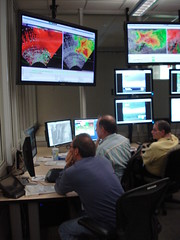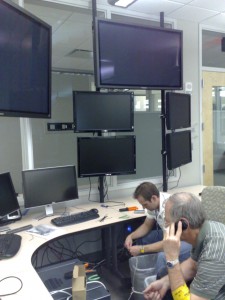A quick look at the PAR data indicates two separate short-lived circulations that passed through Oklahoma County and were scanned by the PAR.
Survey photos KML from Piedmont to Meridian and NW Expressway are attached. There was an almost continuous narrow path between the two locations, though part of it would have been over Lake Overholser.
- Width = 50 yards usually, 120 yards at it’s widest damage point (baseball fields — I walked it off and also measured in Google Earth)
- Length = 7.5 miles
- TS DOD 3 — lots of big trees uprooted in the Ann Arbor and 50th street area –> EF1 (though barely).
- SRB DOD 2 or 4 — concession stand at PCO fields was built like this (concrete blocks, metal roof) and lost about 25% of the roof. –> EF0 or low-end EF1
Too bad there is no EF-scale DOD for movable metal bleachers. I saw loads of those tossed around. One of them badly bent a steel-braced awning at the baseball fields.
A photo from newsok.com was in the back yard of someone’s house in Yukon, so I didn’t get in to see the damage myself. The only other stuff I saw in that area were some stockade fences blown down and some limbs removed (no uprooted trees or anything). So that part of the path could be EF1 based on the picture, but EF0 based on everything else.
Kiel and Angelyn surveyed the Edmond / NOKC circulation. Kiel writes:
I’ll use tornado lightly here…radar really helped pick this guy out. Anyways, attached is Angelyn’s and my survey. Gonna go EF0 on this bad boy…sporadic damage that eventually lined up into a path (2.8 miles long by 20 yards wide).
DI/DODs:
Trees (hard/softwood): DOD 3
Single family home: DOD 2
Aparment building: DOD 2Given the last DI/DOD, winds up to 82 MPH.
- Damage Survey / Geotagged Photos KML of Piedmont-to-Bethany circulation
- Damage Survey / Geotagged Photos KML of Edmond / N OKC circulation
(Travis Smith)







